|
7/20/2015 Prana VayuPrana vayu is the upward current of energy in the body that nourishes the chest, heart, lungs and upper back. It is associated with the inhaling breath and, when activated, creates an uplifting emotional tone. This week we will explore practices to bring awareness and sensitivity to prana vayu through mudra, pranayama and asana. 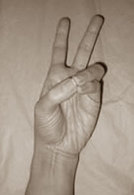 Prana Mudra Breath of Life Touch tips of thumb, ring, and little fingers together, extend index and middle fingers into V shape. Benefits: Activates upward flowing prana in body How it Works: The thumb (fire) joins the ring (earth) and little (water) fingers which acts to balance these elements. The extended index (air) and middle (ether) fingers enhance the upward flowing energy of Prana Vayu. Practice Tips: Use to feel lightness and more energized in the body. Try holding arms overhead and pointing up at the sky Contraindications: Anxiety Pranayama Bolster w/ Elevator Breath Sit in front of the short end of a pranayama bolster or long-folded blanket. Lay back making sure to center spine on prop, you may need extra support under the head. Notice that the position gently opens the chest and abdomen and begin to breathe up and down the spine. The inhale originates at the navel and travels towards the chest like an elevator car going up. The exhale moves back down to the navel like and elevator car going down. Repeat 10-20 breaths. Therapeutics: Encourages activation of prana vayu. 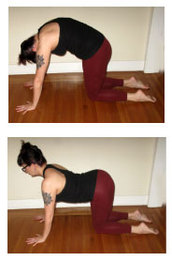 Cat/Cow Tilts Marjaryasana Cat: Exhale round the back and drop the head and tail bone towards the floor. Repeat with your breath 10 times. Cow: Begin on the hands and knees, toes pointed. Inhale lift the sternum forward and drop the pubic bone back between the legs to arch the spine. Notice prana vayu on inhalation moving from the navel towards the chest. Notice apana vayu on exhalation moving from the navel towards the feet. Therapeutics: Massages the internal organs and warms-up the muscles along the spine. 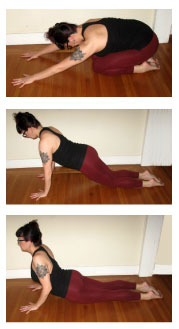 Extended Childs Pose to Cobra Pose Flow Uttita Balasana to Bhujangasana Vinyasa Begin in Balasana with the arms overhead on the floor. Inhale keep hands where they are and move torso through arms to come first into a knee plank position with the shoulders over the wrists, the torso and thighs in a straight line. Then exhale back into Balasana. As you inhale a second time, bring the shoulders over the wrists, lift the heart and come into a gentle backbend with pelvis pressing towards floor. Exhale return to Balasana. Repeat 5-10 times with the breath. Therapeutics: Alternately stretches and strengthens front and back of body.  Palm Tree Pose Talasana Stand in Tadasana with the arms at the sides. Inhale lift up onto balls of the feet as you raise arms forward and either place hands on hips or raise them overhead. Exhale release weight back into heels as you release the arms to sides. Repeat 3-5 times with the breath. Therapeutics: Strengthens arches of feet, ankles and calves, improves balance 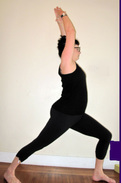 Warrior I with block at wall Virabhadrasana I Begin standing in Tadasana facing the wall. Step left leg back about three feet keeping feet hips width apart. Keep right toes turned forward and left foot turned slightly out. Turn hips gently towards front foot and balance weight on both feet. Bend front knee and place block between shin and wall to stabilize the legs. Press palms into wall and press torso back and up. You may also inhale arms overhead. Draw belly up and release tail bone towards floor. Hold 5-10 breaths then release and change sides. Therapeutics: Opens front body and psoas, strengthens legs, improves balance Downward Facing Dog at Wall Adho Mukha Svanasana Stand facing the wall and place hands on wall at chest height, shoulders distance apart, fingers spread wide. Step feet back until you can press hips back directly over heels. Try not to let the head drop below the arms and widen the shoulder blades across the back body to help support the weight of your torso. Engage the belly and use the quadriceps to press the tops of the thighs back, bending knees if necessary. Hold for 10-20 breaths Therapeutics: Stretches the back body, grounds the thighs and opens the shoulders.  Supported Bridge Pose Salamba Setu Bandha Lay down on the back with the knees bent and feet on the floor. Lift pelvis off floor on an inhalation, place block under sacrum on whichever height is appropriate for you, and rest sacrum on the block. Turn palms up and toes slightly in. Rest up to 5 minutes. 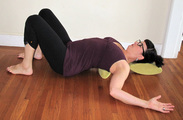 Bricklayers Rest Place two blocks on mat, one perpendicular to mat on lowest height, the other parallel to mat on middle height. The blocks should be 4-6 inches away from each other. Sit facing away from blocks and lie back placing shoulder blades on low block, back of head on high block. Place arms on floor with palms facing upwards. Therapeutics: Opens the heart and relaxes the trapezius muscles of the upper backrt Opener
0 Comments
7/7/2015 Apana VayuThe vayus are the five winds or currents of energy in the body. They help to circulate prana throughout all the systems of the body and maintain their optimal functioning. Apana vayu is the downward flowing energy in the body and is associated with the healthy functioning of the elimination, urinary, and reproduction systems. Associated with the lengthened exhalation, apana vayu begins at the navel and moves down through the pelvis, legs and feet and back to the earth, providing a means of purification by which the earth can receive all that we no longer need for our path forward. This week's practice focuses on grounding the legs to awaken apana vayu energy bringing with it relaxation and ease. 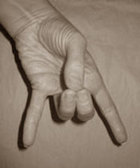 Apana Mudra Grounding Touch tips of thumb, middle and ring fingers together, extend index and little fingers; rest back of hands on thighs. Benefits: Eliminates toxins from the body, creates a sense of calm How it Works: The thumb (fire) joins the index (earth) and middle (ether) fingers. Energy from the head and digestion is drawn downwards as the fingers point towards the earth, Apana Vayu is enhanced. Practice Tips: Use when you need to feel safe and tranquil Contraindications: Low blood pressure Reclining Mountain Pose at Wall Supta Tadasana Lay at the wall with the feet against the baseboard and legs straight. Be close enough to the wall so that you can easily ground the legs into the floor and the feet into the wall. Notice how the floor gently draws the back of the pelvis down toward the heels. Rest the flat palms on the belly in Trimurti mudra. Imagine breathing in through the navel and exhaling down through the pelvis, legs and feet into the wall. If this is difficult to imagine, engage the quadriceps and press into the floor/wall a bit extra when you exhale to engage this downward energy. 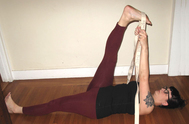 Reclining Thumb to Big Toe Pose I at Wall Supta Padangusthasana I Lay at the wall with the feet against the baseboard and legs straight. Be close enough to the wall so that you can easily ground the legs into the floor and the feet into the wall. Draw your right knee into your chest and lengthen the left leg onto the floor. Wrap a strap around the ball of your right foot and extend the leg into the air. Reach the hands up the strap until the elbows are straight but the shoulders are still grounded. Hold for 10-20 breaths. Therapeutics: Stretches the hamstrings, calves, buttock; also releases tension in the lower back. 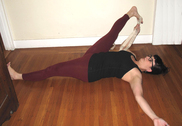 Reclining Thumb to Big Toe Pose II at Wall Supta Padangusthasana II Lay at the wall with the feet against the baseboard and legs straight. Be close enough to the wall so that you can easily ground the legs into the floor and the feet into the wall. Place a block on the outside of the right hip. Wrap strap around the ball of the right foot, extend the leg and hold the strap in just the right hand. Externally rotate your leg and as you exhale , lower the leg directly out to the side so that the outer thigh rests on the block. Extend the foot into the strap and reach the left arm out to the side keeping the left hip on the floor. To release, use the inner thigh to draw the leg up to center. Hold for 10-20 breaths then release to center. Therapeutics: Stretches the hamstrings, calves, inner thigh, outer hip and buttock; also releases tension in the lower back. 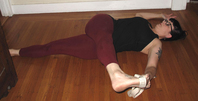 Reclining Thumb to Big Toe Pose III at Wall Supta Padangusthasana III Lay at the wall with the feet against the baseboard and legs straight. Be close enough to the wall so that you can easily ground the legs into the floor and the feet into the wall. Place a block on the outside of the right hip. Wrap strap around the ball of the right foot, extend the leg and hold the strap in the left hand and slowly bring the leg across the body as you twist the lower body, keeping the shoulders on the floor and the right arm out to the side. To release, drop the right hip into the floor and allow the leg to follow. Hold for 10-20 breaths then release to center. Therapeutics: Stretches the outer hamstrings, calves, outer hip, buttock; also releases tension in the lower back. 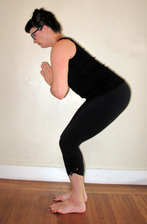 Chair Pose at Wall Utkatasana Begin in Tadasana in frotn of wall. Bend both knees and lean pelvis back to wall, then lower pelvis slightly, grounding the thighs. Inhale hands either to hips, arms parallel to floor or overhead. Exhale and lean torso forward from hips as you sit back bending the knees. Be sure that the knees do not go forward of the ankles and do not arch the lower back excessively. Hold 5-10 breaths and release. Therapeutics: Strengthens legs, core and lower back 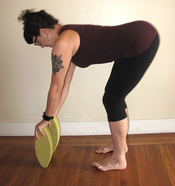 Half Standing Forward Bend at Wall Ardha Uttanasana Begins standing in Tadasana about six inches from wall. Bend forward from hips and place fingertips on either floor, blocks or tops of knees with arms straight. Press hips back into wall and feet into floor. Open heart forward and draw thighs and sit bones back. Hold for 10 breaths, release into Uttanasana. Therapeutics: Stretches front torso, backs of legs Downward Facing Dog at Wall Adho Mukha Svanasana Stand facing the wall and place hands on wall at chest height, shoulders distance apart, fingers spread wide. Step feet back until you can press hips back directly over heels. Try not to let the head drop below the arms and widen the shoulder blades across the back body to help support the weight of your torso. Engage the belly and use the quadriceps to press the tops of the thighs back, bending knees if necessary. Hold for 10-20 breaths Therapeutics: Stretches the back body, grounds the thighs and opens the shoulders. 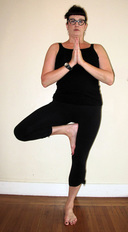 Tree Pose at Wall Vrksasana Stand with right side facing wall, Engage legs and bear weight on left leg only. Draw right foot onto calf or inner thigh (do not press on side of knee). Press right foot against left leg and squeeze the left leg against the right foot. Press right knee toward wall so that thigh is at a 40 degree angle. Make sure that hips are even to the floor. Draw belly in and release tail bone towards floor. Inhale and draw arms overhead without gripping shoulders. Hold as long as you can balance with comfort, release and change sides. Therapeutics: Mental focus and balance, leg strength, stretches inner thighs 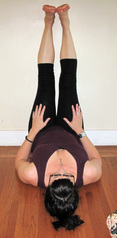 Legs up the Wall Sit beside wall. Swing legs up wall as you lay back on mat. Rest hands on lap, belly or place arms out to sides with palms facing up. Rest at least 10-15 minutes, then roll over to release. The back should be relatively flat on the floor and the legs can be slightly bent, especially if the hamstrings are tight. Therapeutics: Activates the Relaxation Response, reduces swelling in the legs and feet, balances the nervous system, good if you have been sitting or on your feet all day. |
Index:Archives:
September 2022
I attend Cheryl's class regularly and feel that my practice has improved immensely over the past few years due to her expert coaching. Her teaching style is clear and compassionate and her previous experience in teaching adults is evident in her organized approach and easy to understand instructions. I also appreciate that Cheryl not only teaches us about how to correctly position ourselves, but also touches on many aspects of yoga philosophy, which in turn has deepened my personal practice and heightened my awareness of the connection between mind and body, breath and relaxation. |

 RSS Feed
RSS Feed
